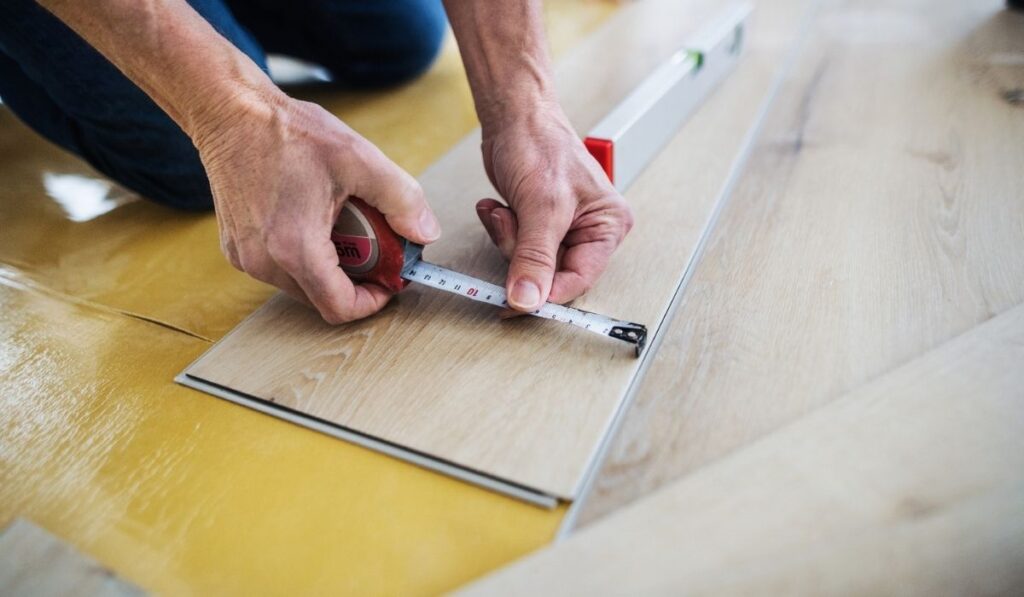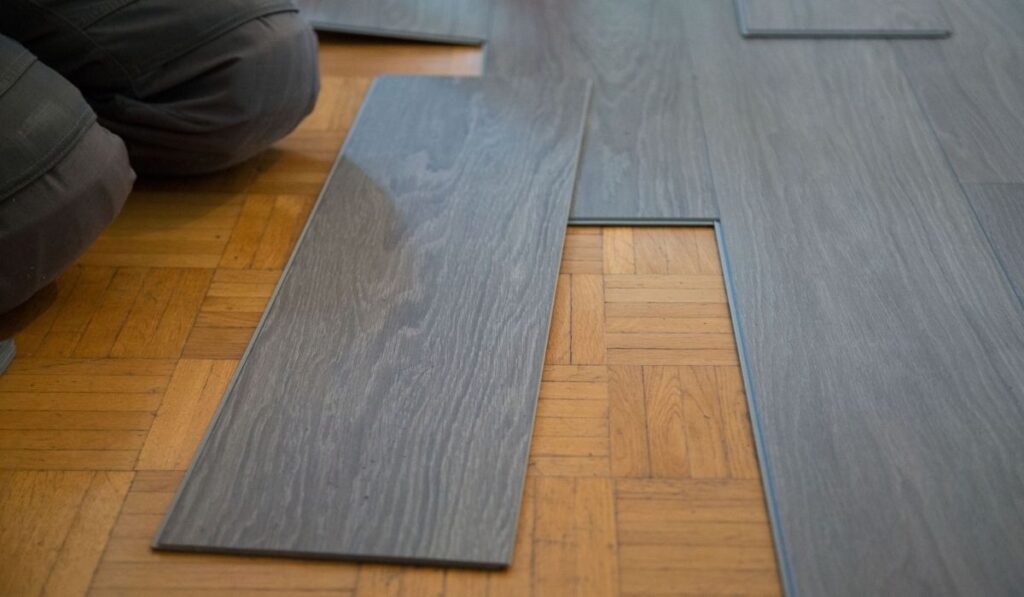Vinyl flooring may be the next big thing in home décor since it’s easy to install and provides an appealing, natural look. But while vinyl plank flooring is quite durable and scratch-resistant, it’s also susceptible to dents and marks, especially when heavy objects in the home aren’t handled carefully. So, how do you put your fridge on vinyl flooring without causing damage?
You can avoid creating dents and marks on your vinyl flooring by using caster cups and rubber mats underneath your refrigerator. If you need to move your fridge, cover the path with plywood, shut the refrigerator door tightly, and use a moving dolly to transport the appliance to its new location.
Vinyl flooring should last as long as you want it to and maintain properly. That’s why you should familiarize yourself with the protective steps to keep your flooring in tip-top shape. We’ll look at some of those, but first: how to properly place your fridge on vinyl flooring.
What Is Vinyl Flooring?

Vinyl flooring comprises different layers of several materials joined together to create a strong, durable, and practical floor covering. There are two major kinds of vinyl flooring: Vinyl rolls and Luxury Vinyl Tiles (LVT).
Although they are both created with the same materials, they don’t have the same construction. This means that each type of vinyl flooring has different benefits.
LVT is designed to look like the typical natural flooring styles, such as ceramic tile and hardwood. You have technological advancement to thank for this innovation; now, you don’t have to get the actual materials to have an almost identical natural flooring option.
LVT is available in different designs meant to mimic natural materials, both in plank and tile styles. These tiles can be flexible or rigid. LVT is easy to install, making it a highly sought-after option.
On the other hand, Vinyl roll is made of fiberglass and is available in large and flexible sheets. Vinyl rolls are also affordable; they come in several styles, and they’re environmentally friendly because they are 100% phthalate-free.
Overall, whether it’s LVT or vinyl roll, vinyl flooring is trendy, affordable, waterproof, and scratch-resistant. In terms of durability, this kind of flooring lasts between 5 and 25 years, although how long it lasts depends on its quality, maintenance, and installation.
Can You Put a Refrigerator on Vinyl Plank Flooring?
Since vinyl flooring isn’t the typical flooring we’re accustomed to, there are certainly some peculiarities to its application. For example, you might be wondering if you can place heavy objects, including a refrigerator, on it.
Fortunately for you, one vinyl plank is sturdy, durable, and can hold up to 500 pounds of weight. Since you’ll be using more than one plank during installation, you can be certain that bulky items can sit on top of them, including a refrigerator. Your vinyl flooring won’t crack or get damaged when you put heavy furniture or appliances on it.
Still, you have to be careful. Vinyl flooring might be scratch-resistant, but that doesn’t mean that it’s totally immune to dents and marks. Carelessly handling your appliances and letting them drop on the flooring can cause cuts.
You might not always be able to prevent this from happening, so you need to know what to do if a dent appears. Here are some steps you can take to deal with a dent:
- To get started, you should clean the floor to make sure it’s free from stains and dirt. You can do this with warm water and soap. Then, let the floor dry.
- Next, please turn on your iron and place it on the cotton setting. While it heats up, put a damp towel — not dripping — on the dented area.
- Hold the heated iron over the dented areas for about three minutes. Don’t place the iron directly on the damp towel; just let it hover.
- If the iron method doesn’t work, you can use a hairdryer instead. Place it on the lowest setting and use it over the dent for a few minutes. Afterward, you can use a steel roller (on Amazon) to gently roll out the affected area.
- Finally, if it looks like the vinyl flooring is at the point of no return, you can either leave it that way or contact a professional to help you remove and replace the vinyl plank.
How Do You Move a Refrigerator With Vinyl Plank Flooring?
We’ve already established that vinyl floors are durable and scratch-resistant, but we’ve also mentioned that you still need to be careful when handling them. That’s why you have to move a refrigerator across this kind of floor with caution. Otherwise, the appliance’s weight can strain the material, tearing it and potentially damaging the floor.
To successfully move a refrigerator on a vinyl floor without damaging anything along the way, you should follow the steps below. These items will be needed:
- Plywood
- Ropes or bungee cords
- Moving dolly (on Amazon)
- Moving straps (on Amazon)
Once you have these items, you can go ahead with the following:
- Place the sheets of plywood on the floor. Make sure that they cover the entire area over which you’ll be moving the refrigerator.
- Take out food and other items that you’ve stored in the fridge and its freezer compartment. Tightly shut the appliance and tie ropes or cords around the refrigerator to prevent the door from opening while you’re moving it.
- Disconnect the fridge from the socket and move it away from the wall. Tilt the fridge away from where you’re standing, and place a moving dolly under it. Hold the appliance in place with moving straps.
- While maintaining total control, slant the dolly and move it along the plywood you laid in step one. Slowly move the appliance from where it used to be to its destination. That could be the garage, a truck, or a different location in the house.
- After moving the appliance, remove the plywood from the floor. You’ll find that the vinyl flooring is unaffected since the plywood has absorbed the weight of the fridge.
It would help if you always asked for help whenever you needed to move your fridge. Asking for help from at least one or two people will make it easier and safer for you to move the appliance.
How Can You Protect Your Vinyl Floor Under the Fridge?
Although vinyl floors can support heavy appliances like refrigerators, an indent could form after an extended period. To prevent this from happening, it’s always recommended to place a buffer between your heavy appliance (in this case, a fridge) and the floor.
One way you can protect your vinyl floor under the fridge is to place caster cups on the legs of your appliance. Caster cups like these CasterMaster 3×3 Square Rubber Caster Cups (on Amazon) and SoftTouch Furniture Caster Cups (also on Amazon) should stop the refrigerator from denting the vinyl floors.
Other reasons why you should use caster cups are as follows:
- They will prevent your appliance from leaving marks or scratches on your vinyl floor.
- Since they’re protecting your vinyl floor from dents and scratches, the flooring will last for as long as possible.
- Caster cups won’t discolor the floor even after a long period of use.
- You don’t need any special tools and knowledge to apply caster cups. They are easy to install; all you have to do is place them under your appliance’s legs.
- Caster cups are durable and will last as long as you use them.
- They are very affordable.
Another way you can protect your vinyl floor is to use a rubber mat underneath the refrigerator, and a good example is the Amazon Basics Vinyl Protector (on Amazon). This mat will serve as a good cushion between the floor and your refrigerator.
Other Ways You Can Protect Your Vinyl Floor From Damage

It’s not just the refrigerator that can damage your vinyl floor; other heavy appliances in the house are also a risk. This is why you should use other protective measures to ensure that the ground doesn’t get damaged by any of these appliances. Here are some safety tips you can practice to protect your vinyl floor:
- Don’t drag items across the floor: If you need to move objects around the house, try not to drag them along the floor. Doing so can result in unsightly scuff marks. It would be best if you lifted the objects instead.
- Use pads: No matter what you do, you should always use furniture pads around the house. You can place them underneath the refrigerator, couch, stove, etc. Furniture pads will help keep the floor free from scratches.
- Place rolling chair mats on the floor: If you have rolling chairs in your house, you should also get rolling chair mats on the floor beneath them. Rolling chairs might seem harmless at first, but constantly moving them back and forth can affect the vinyl floor. It’s best to place a PVC chair mat like Amazon Basics Vinyl Protector (on Amazon) below the chair.
- Use rugs in the house: Using rubber-backed or plastic mats can discolor the vinyl planks. That’s why it’s better to use rugs tagged as vinyl-backed or colorfast.
